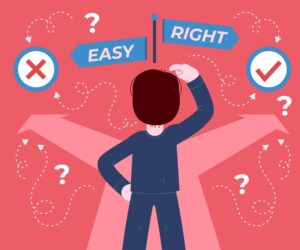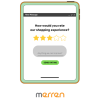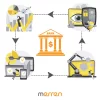Are your customers getting tired of filling out surveys? Survey fatigue can negatively impact response rates, skew results, and damage your brand reputation. But fear not! There are techniques to reduce survey fatigue and increase engagement. In this blog, we will explore the causes and risks of survey fatigue, as well as effective techniques to minimize it. We’ll also discuss how to write effective survey questions, find the ideal length for a survey, and design a user-friendly interface. Lastly, we’ll cover emerging technologies and strategies that can help reduce survey fatigue. By implementing these tips and tricks, you can improve your feedback collection process and make better business decisions.
What is Survey Fatigue?
Introducing customer surveys can be an instrumental tool for extracting valuable feedback, but it comes with its own set of challenges. Survey fatigue is a common issue faced by customers who are bombarded with lengthy or irrelevant surveys.
Spotting the signs of survey fatigue and implementing strategies to reduce it can significantly improve response rates and yield more accurate results. By addressing this problem, companies can ensure they receive meaningful insights that help them make informed decisions.
Understanding Survey Fatigue and Its Impact on Survey Results
Over-surveying customers can lead to survey fatigue, which can result in biased and inaccurate survey results. If customers are continually bombarded with surveys, they may become less willing to participate, leading to lower response rates and potentially skewed results. Additionally, survey fatigue can waste valuable time and resources, damage brand reputation, and even cause the loss of customers. It’s crucial to minimize this phenomenon by creating shorter and more targeted
surveys, offering incentives for participation, and using alternative feedback methods like customer feedback forums.
Causes of Survey Fatigue
Long surveys are one of the leading causes of survey fatigue. Respondents are more likely to abandon a survey if it appears too lengthy, especially if it contains many irrelevant or repetitive questions. Additionally, complex questions that require a lot of thought and attention can frustrate respondents and cause them to lose interest. To prevent survey fatigue, surveys should be concise and targeted to the specific needs of each customer segment, ensuring that respondents only receive surveys that are relevant to them.
Targeting the Wrong Audience

Effective survey results are highly dependent on reaching the right audience. Targeting the wrong group of people can lead to irrelevant or repetitive questions, causing respondents to lose interest quickly. To avoid survey fatigue, businesses should ensure that their surveys are relevant and targeted towards the right audience. Utilizing skip logic can help tailor questions to each respondent’s specific needs, while keeping surveys short and concise can prevent respondents from feeling overwhelmed or bored. Regularly reviewing and updating survey questions can also help keep them fresh and engaging for your target audience.
Using Long Survey Questions
Long survey questions can lead to survey fatigue among customers, resulting in lower response rates and skewed results. To prevent this, it’s best to keep survey questions concise and focused on specific topics. Consider breaking up longer surveys into multiple shorter surveys to avoid overwhelming respondents. Additionally, using skip logic in surveys can help tailor questions to each respondent’s needs, making the experience more personalized and engaging. By reducing survey fatigue, businesses can gain more accurate feedback from their customers.
Read our blog on writing a good survey
Asking Repetitive Questions
Asking repetitive questions during a survey can cause respondents to feel like their time is being wasted. This can lead to survey fatigue and poor customer experience which would result in inaccurate responses or a lower response rates and completion rates. To avoid this, it’s essential to ensure that the questions are clear, concise, and focused on gathering necessary information. It’s also crucial to avoid using similar-sounding or identical questions in your survey. By doing so, you’ll prevent monotony and make the survey experience more engaging for respondents. Additionally, offering incentives or rewards for completing surveys can motivate respondents to provide thoughtful and accurate feedback.
Poor Survey Design
A poorly designed survey can lead to survey fatigue as respondents may feel overwhelmed or disengaged. Cluttered layouts, confusing instructions, and lengthy or repetitive questions can all contribute to poor respondent engagement. To avoid these issues, it’s crucial to keep surveys short and focused on specific topics. Use clear language and avoid technical jargon that may confuse respondents.
Additionally, offering incentives or rewards for completing the survey can help motivate respondents to provide thoughtful and accurate feedback. By prioritizing good survey design practices, businesses can reduce survey fatigue and receive valuable insights from their customers.
Too Many Surveys (Over-Surveying)
Over-surveying can be a significant contributor to survey fatigue, leading to lower response rates and poor quality feedback. It is essential to consider the frequency and timing of your surveys, making sure each survey has a clear purpose and is relevant to the customer. Offering incentives or rewards for completing surveys can encourage participation while maintaining quality responses. By avoiding over-surveying, you can reduce the risk of survey fatigue and collect better feedback for informed decision-making.
Risks of Survey Fatigue
Survey fatigue poses a significant risk to businesses, leading to decreased response rates, lower quality feedback, and inaccurate decision-making. Over-surveying customers can cause frustration and annoyance, ultimately resulting in a loss of customers and damage to brand reputation. In addition, survey fatigue can skew data and lead to wasted time and resources. To mitigate these risks, it is essential to implement strategies such as shorter surveys, offering incentives, and asking for feedback at the right time. By doing so, you can reduce survey fatigue and improve your overall feedback collection process.
Lower Response Rates

Lower response rates due to survey fatigue can have a significant impact on the quality of feedback obtained. When customers become disinterested or overwhelmed by frequent requests for feedback, they may be less likely to respond, resulting in a biased sample that does not accurately reflect their true opinions. To prevent lower response rates and improve the quality of feedback, consider limiting the frequency and length of surveys sent out to customers. Providing incentives such as rewards or discounts can also encourage participation and improve response rates.
Read our ultimate guide on boosting survey response rate
Skewed Results
Survey fatigue can lead to skewed results that can negatively impact decision-making. Incomplete or inconsistent answers due to fatigue can cause inaccurate data, resulting in poor strategy development. To reduce survey fatigue and improve the accuracy of results, consider shortening the length of surveys, providing incentives, and using interactive and engaging question formats. By taking these steps, you can encourage participants to provide well-thought-out responses and ensure that your survey results are reliable and accurate.
Wasted Time and Resources
Survey fatigue can lead to wasted time and resources, as customers may become disinterested in completing surveys or opt-out of future feedback opportunities. This can result in a loss of valuable insights, hindering decision-making processes. To prevent this, it’s important to prioritize the most important questions and limit the number of surveys sent to customers. Additionally, using incentives
or offering personalized surveys can help increase engagement and reduce survey fatigue, ultimately leading to more accurate data collection and better decision-making.
Damage to Brand Reputation
Survey fatigue can have a significant negative impact on a company’s brand reputation. Customers may become frustrated with the frequency or length of surveys, leading to a decrease in response rates and potentially damaging the company’s image. This is especially true if the surveys are irrelevant or not valuable to the customer. To reduce the risk of survey fatigue, it’s important to limit the number of surveys sent and ensure they are targeted towards relevant and valuable feedback. Providing incentives or rewards for completing surveys can also help improve response rates and reduce negative perceptions of your brand.
Loss of Customers
Survey fatigue can be detrimental to customer retention as it leads to disengagement or frustration. Losing customers due to excessive surveys is a real risk, and businesses must find a balance between gathering feedback and maintaining customer engagement. Shorter, more personalized surveys with incentives for participation can help reduce the risk of survey fatigue and encourage customer loyalty. It’s essential to communicate the value of feedback and respect the respondents’ time to prevent losing customers due to survey fatigue.
Techniques to Reduce Survey Fatigue
To reduce survey fatigue, it’s essential to keep surveys concise and straightforward. Using different types of survey questions, such as multiple choice and open-ended questions, can also help keep customers engaged. Providing incentives, such as discounts or free products, is another effective technique to encourage customers to participate. To avoid overwhelming customers, limit the number of surveys sent and space out survey requests. Analyzing feedback from previous surveys can also help identify areas for improvement and make necessary changes to prevent survey fatigue.
Keep Surveys Short and Contextual
To avoid survey fatigue, it’s essential to keep surveys short and contextual. Lengthy surveys can lead to decreased response rates and disengagement from customers. By keeping surveys short and contextual, businesses can increase response rates and obtain more accurate feedback. Contextual questions that relate to recent experiences with the company are more engaging and relevant, while including open-ended questions allows customers to share their thoughts in their own words. Using a variety of question types, such as multiple-choice and Likert scale questions, also keeps the survey interesting and prevents monotony.
Read how to optimize your survey length by prioritizing your questions.
Don’t Over-Survey Your Audience
When it comes to surveying your audience, it’s crucial to strike the right balance. Because every survey has a baring on the response rate of your future surveys. So while you want to gather valuable feedback and insights, it’s important not to overdo it. Over-surveying can lead to survey fatigue, where customers become disinterested or even annoyed with your company. To avoid this, prioritize the surveys that are most important for your business goals and limit the number of surveys sent to each customer. Consider using a survey schedule or calendar to ensure you are given them enough time between requests. Additionally, offering incentives for completing surveys can increase engagement and reduce fatigue.
Use Conversational Surveys to Boost Engagement
Online survey forms are boring, tedious, and intimidating for the customers. To combat survey fatigue and increase engagement with customers, consider using conversational surveys. Conversational surveys use a more informal and personalized approach to gather feedback, making the process feel less like a chore and more like a conversation. They provide a great way for reduced survey fatigue.
This can lead to higher response rates and more valuable insights. Using WhatsApp, FB Messenger, chatbots, AMP email, and in-app surveys can also help businesses automate the survey process while still maintaining a conversational tone. By making the survey experience more enjoyable for customers, businesses can reap the benefits of more accurate and meaningful feedback.
Provide an Estimated Time for Survey Completion
When it comes to reducing survey fatigue, providing an estimated time for completion can go a long way in managing respondent expectations. By letting customers know how much time they need to set aside, the likelihood of abandonment or fatigue is reduced. It’s important to provide as accurate an estimate as possible and to overestimate rather than underestimate. For longer surveys, consider breaking them up into smaller sections that survey respondents can complete at their convenience. Additionally, using skip logic and only asking relevant questions can help reduce survey length and ultimately prevent fatigue.
Segment Your Audience to Send Personalized Surveys
To combat respondent fatigue, audience segmentation can be an effective technique. By sending personalized surveys to specific segments of your audience, you can tailor the questions and content to their interests and needs. Demographics, behavior, and preferences are factors to consider when segmenting your audience for surveys. Personalization can make customers feel valued and more willing to provide feedback. Using survey tools that allow for automated segmentation and personalization can save time and effort.
Incentivize Your Survey to Boost Engagement
Offering incentives can be an effective way to boost survey engagement and reduce survey fatigue. By providing something of value to participants, such as discounts, free samples, or entries into prize drawings, you can motivate them to take the time to provide feedback. However, it’s important to ensure that the incentive is relevant and valuable enough to make it worth their while. Consider offering different levels of incentives based on the length or complexity of the survey and make sure to be transparent about what participants can expect in terms of rewards and when they will be received.
Writing Effective Survey Questions to Minimize Fatigue
Asking effective survey questions is crucial when it comes to reducing survey fatigue. Keeping questions short and straightforward, avoiding jargon or biased language, and using a variety of question types can all help to create engaging surveys that are less likely to overwhelm respondents. Additionally, limiting the number of questions in each survey and testing them with a small audience before sending them out can ensure that your survey is well-received and provides valuable feedback.
Ask the Right Questions

Crafting effective survey questions is essential to reduce survey fatigue among your customers. It’s crucial to keep your questions clear, concise, and relevant to the feedback you are seeking. Avoid lengthy and complicated questions that may confuse or frustrate your customers. Consider using different question formats such as multiple-choice or rating scales to make it easier for customers to respond. Limiting the number of questions in your survey can also help prevent overwhelming your customers. By asking the right questions, you can not only minimize survey fatigue but also maximize the quality of feedback you receive from your audience.
Be Clear and Concise in Your Language
To avoid survey fatigue, it’s important to use clear and concise language in your survey questions. Keep in mind that using complex or technical terms may be unfamiliar to your customers, leading to confusion and frustration. Instead, use simple language and avoid lengthy sentences to make it easier for customers to understand the question. Additionally, breaking down complex questions into smaller, more manageable parts can help reduce fatigue and improve response rates.
Avoid Leading Questions and Bias
It’s essential to create unbiased and precise survey questions to obtain reliable and valuable feedback. Leading questions can influence the respondent’s opinion, leading to inaccurate results. To avoid bias, use neutral language and avoid assumptions or opinions in the question. Open-ended questions allow for detailed responses without limiting options for respondents. By keeping surveys concise and relevant, you can avoid overwhelming or frustrating the survey taker while creating effective survey questions that minimize fatigue and provide valuable feedback.
Read 15 commonly made mistakes in writing a good survey.
Use Visual Aids to Enhance Understanding
Incorporating visual aids, such as images or videos, can significantly improve respondents’ understanding and engagement with the survey. Visual aids are particularly useful when asking complex or technical questions that may be difficult to comprehend through text alone. Not only do they help in recalling past experiences, but they also make the survey more enjoyable for respondents, which ultimately leads to a better response rate. By using visual aids in your surveys, you’ll be able to minimize survey fatigue and increase the quality of your data.
If you find survey writing from scratch is intimidating, the best way to use out AI Survey Builder to build one for you in seconds.
Ideal Length of a Survey to Avoid Fatigue
Length of your survey is the biggest predictor of survey fatigue. Shorter surveys are more effective in limiting survey fatigue. It’s essential to consider the purpose of the survey research and tailor questions accordingly. Use skip logic to avoid asking irrelevant questions, as overcomplicating a survey can lead to higher drop-off rates. Offering incentives or rewards for completing the survey can also be a powerful tool in keeping participants engaged. Testing the survey with a small group before sending it out to a larger audience will help ensure that the length is appropriate and effective. By finding the ideal length for your specific audience, you can reduce survey fatigue and increase response rates.
Finding the Ideal Length for Your Audience
Different audiences have different requirements when it comes to survey length. Shorter surveys are preferred by customers with busy schedules or attention spans, while more engaged customers may respond better to longer surveys that gather in-depth feedback. Consider using skip logic to ensure respondents answer only relevant questions. Testing the survey on a small audience before sending it out widely can also help determine an ideal length for your specific audience. Don’t forget that
sending out surveys at the right frequency can also help reduce survey fatigue and improve response rates.
The Role of Survey Interface Design in Reducing Fatigue

In today’s fast-paced world, customers are increasingly short on time and overwhelmed with information. To keep them engaged, it’s crucial to design surveys that are not only informative but also visually appealing and easy to navigate. The interface design of a survey plays a critical role in reducing survey fatigue, as well as improving response rates and feedback quality. By simplifying the survey layout, incorporating visual elements, and making it user-friendly and accessible, you can help customers complete surveys effortlessly without feeling overwhelmed or exhausted.
Simplify the Survey Interface Design Or Use Familiar Ones
Creating a survey that is easy to navigate and understand is crucial in reducing survey fatigue. To simplify the interface design, use clear and concise language, avoid technical jargon, and reduce the number of questions. By eliminating unnecessary or redundant questions, you can create a more visually appealing survey that is easier for customers to complete. Additionally, incorporating interactive features such as progress bars or animations can help keep customers engaged and prevent them from abandoning the survey due to boredom or frustration.
Alternatively, try using channels that your audience is already familiar with. Messaging apps, like WhatsApp and FB Messenger, for example, provides an interface that are very familiar and comfortable with. It is no surprise that these mediums get very high respose rates
Make It User-Friendly and Accessible
When designing a survey, it’s essential to ensure that the interface is user-friendly and accessible. This means using clear language and intuitive design to make the survey easy to navigate. Incorporating visual aids like images or videos can also help users understand the questions better. Making the survey accessible by providing alternative formats for those with disabilities and using responsive design to adapt to different screen sizes are also crucial factors to consider while
creating a user-friendly survey. By simplifying the interface design and making it more accessible, respondents are more likely to engage with your surveys without experiencing fatigue.
How Do You Deal With Survey Fatigue?
To minimize survey fatigue, it is crucial to keep the survey short and focused on specific topics. Use skip logic to avoid asking irrelevant questions, and consider offering incentives such as discounts or freebies for completing a survey.
Personalizing the survey experience by addressing respondents by name and tailoring questions to their interests can also improve response rates. Lastly, make sure the survey is accessible across different devices and platforms for ease of use. Communicating the importance and value of the survey while respecting the respondent’s time and effort can significantly reduce survey fatigue.
Impact of Survey Fatigue On Response Rates
High response rates are a crucial aspect of survey feedback and decision-making. However, over-surveying customers can lead to decreased response rates due to survey fatigue. This can ultimately result in skewed results, wasted time and resources, and even damage to brand reputation. To prevent survey fatigue and maintain high response rates, it’s important to limit the frequency of surveys and use targeted surveys for specific customer segments. Additionally, offering incentives such as discounts or rewards can further reduce the impact of survey fatigue.
How Merren Helps Reduce Survey Fatigue
Merren is omnichannel survey and customer experience tool that uses conversational mediums like WhatsApp, FB Messenger, chatbots, Email surveys including embedded linked based, HTML and AMP to collect customer feedback. Merren helps reduce survey fatigue by offering a personalized survey experience that is short, focused, and accessible across channels.
With Merren, you can build a smart channel strategy to collect feedback. For example , you can send WhatsApp surveys to those who visited your offline store instead of online surveys. WhatsApp is more accessible to the customer when they are in your store or have just finished the transaction.
Similarly, if for the customers on your website , you can use targeted chatbots or in-page surveys to gather their feedback, providing a seamless and convenient experience.
Merren also offers real-time analysis and reporting of survey data, enabling businesses to quickly take action based on customer feedback. By reducing survey fatigue and improving response rates, Merren helps businesses make better-informed decisions that positively impact their bottom line.
Conclusion
The challenge of survey fatigue is real. Too many surveys sent without proper planning can lead to respondent fatigue and poor survey results. It’s important to keep survey design simple, relevant, and engaging so respondents don’t get frustrated and stop responding. Use our tips to help reduce survey fatigue and boost your customer feedback loop. Contact us today to learn more!





